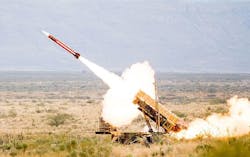Army approaches industry to ways to upgrade or replace Patriot missile-defense radar system
PICATINNY ARSENAL, N.J., 7 July 2016. U.S. Army missile experts want to upgrade or replace the radar systems on the Patriot air-defense missile system, and they are surveying industry to find companies able to do this.
Officials of the Army Contracting Command at Picatinny Arsenal, N.J., issued a request for information Wednesday (W15QKN16X06UY) for the Lower Tier Air and Missile Defense Sensor (LTAMDS) project to consider upgrades or replacements to the Patriot missile radar.
The Army wants to upgrade or replace the current Patriot radar to improve its effectiveness against emerging threats and reduce maintenance costs.
The Army Raytheon Patriot is a surface-to-air missile (SAM) that uses the Raytheon AN/MPQ-53 phased-array radar for high- to medium-altitude air defense against enemy aircraft and ballistic missiles. Army leaders want to keep Patriot in the field until at least 2040.
Related: Raytheon unveils major enhancements to Patriot missile command and control capability
Army experts want new or upgraded Patriot radar systems that cost less than $50 million per installation. Solutions must be at least as mature as component and breadboard validation in relevant environments (Technology Readiness Level 5) by late 2017.
The Army Contracting Command is issuing this RFI on behalf of the Army Lower Tier Project Office (LTPO). Patriot is short for Phased Array Tracking Radar to Intercept of Target.
A team from the Army Aviation and Missile Research Development and Engineering Center (AMRDEC), Georgia Tech Research Institute (GTRI), University of Alabama in Huntsville (UAH), Wyle-CAS, Dynetics, and Torch Technologies will evaluate industry responses in efforts to shape requirements for future Patriot radar enhancements.
Key performance requirements of an enhanced Patriot radar are in a classified document available to interested companies with the appropriate security clearances.
story continues below
From industry the Army wants descriptions of proposed solutions; expected per-unit costs of radar upgrades or replacements for 80 Patriot radars over 10 years; and expected test schedules.
Army experts also are interested in technologies critical to a Patriot radar upgrade or replacement, including high-power amplifiers, low-noise amplifiers, limiters, low-noise oscillators, AC-DC and DC-DC power supplies, antennas, cooling systems, and prototypes.
Army experts will brief industry on the LTAMDS on 21 July 2016 at 106 Wynn Drive in Huntsville Ala. Those who would like to attend the briefings should email lists of attendees no later than 15 July 2016 to the Army's Michael Mannario at [email protected].
Companies interested should send responses no later than 2 Aug. 2016. Email unclassified responses to the Army's Gregory Smith at [email protected]. Send classified responses by post or by courier to PEO Missiles and Space, Attn: SFAE-MSL-LTG, Bldg. 5250, Martin Rd.,Redstone Arsenal, AL 35898.
Related: Raytheon to upgrade venerable Patriot missile system with GaN AESA radar technology
Email requests for the classified RFI requirements document, entitled Lower Tier Air and Missile Defense Sensor (LTAMDS) Requirement Guidelines, to Michael Mannario at [email protected].
For questions or concerns contact Michael Mannario by email at [email protected], or by phone at 973-724-9914. More information is online at https://www.fbo.gov/notices/35fb9706395f023d73813bc935d83300.
Learn more: search the Aerospace & Defense Buyer's Guide for companies, new products, press releases, and videos

John Keller | Editor
John Keller is editor-in-chief of Military & Aerospace Electronics magazine, which provides extensive coverage and analysis of enabling electronic and optoelectronic technologies in military, space, and commercial aviation applications. A member of the Military & Aerospace Electronics staff since the magazine's founding in 1989, Mr. Keller took over as chief editor in 1995.

